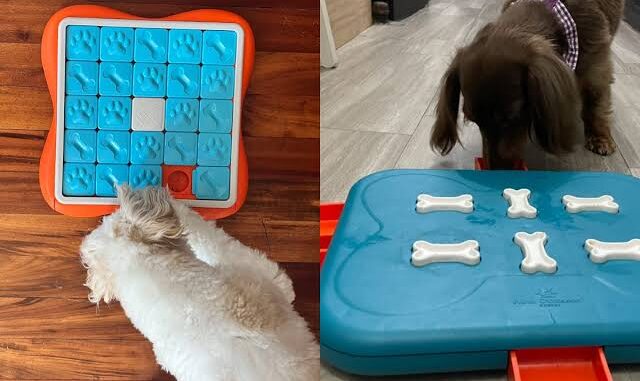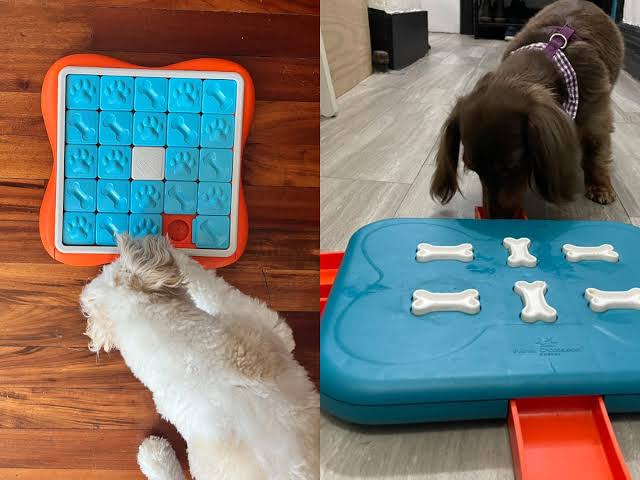
The Best Puzzle Toys for Dogs: Keeping a dog mentally stimulated is just as important as providing physical exercise. That’s where puzzle toys come in. These engaging tools challenge your dog’s brain, improve problem-solving skills, and help reduce boredom, anxiety, and even destructive behavior.

Whether you have a high-energy pup, a senior dog, or a curious canine who just needs a little more mental enrichment, puzzle toys offer hours of rewarding play. In this guide, we’ll explore the best puzzle toys for dogs in 2025, categorized by difficulty level, dog size, and interactive features—along with a deep dive into what makes each one special.
Why Puzzle Toys Are Essential for Dogs
Puzzle toys are more than just entertainment—they serve multiple purposes:
- Mental stimulation: Helps prevent boredom and keep your dog’s brain active.
- Stress relief: Reduces anxiety by providing focused activity.
- Slows down eating: Many puzzle feeders double as slow feeders to prevent gulping.
- Builds confidence: Encourages independent problem-solving.
- Improves behavior: A mentally satisfied dog is less likely to chew furniture or bark excessively.
Dogs of all ages benefit from puzzle toys, but they are especially valuable for:
- Puppies in training
- Dogs with high intelligence or energy
- Seniors who need low-impact enrichment
Types of Dog Puzzle Toys
- Treat Dispensers – These reward your dog with treats or kibble as they interact with the toy.
- Slide Puzzles – Dogs move sliders or pieces to uncover hidden treats.
- Hide-and-Seek Toys – Soft toys where smaller toys are hidden in larger ones.
- Interactive Electronic Toys – Sensors or timers engage your dog with movement, lights, or sounds.
- Chew-Based Puzzle Toys – Combine durability with mental challenge (e.g., KONGs filled with food).
Top Puzzle Toys for Dogs in 2025
1. Outward Hound Nina Ottosson Dog Tornado
Best For: Beginners to intermediate puzzle-solvers
How It Works: Dogs spin rotating discs to reveal treats underneath.
Why It’s Great: Durable, dishwasher-safe, and engaging without being too frustrating.
Highlights:
- Four layers of rotating compartments
- Non-slip base
- Ideal for small to medium breeds
2. KONG Classic Dog Toy
Best For: All ages and sizes
How It Works: Fill it with treats, peanut butter, or frozen goodies for hours of chewing and problem-solving.
Why It’s Great: Combines chewing and mental stimulation. Great for crate training and anxiety relief.
Highlights:
- Ultra-durable rubber
- Bounces erratically
- Can be frozen for added difficulty
3. Pet Zone IQ Treat Ball
Best For: Dogs who eat too fast
How It Works: Your dog must roll the ball around to dispense kibble or treats.
Why It’s Great: Adjustable difficulty settings make it great for progression.
Highlights:
- Reduces fast eating
- Promotes active play
- Great for small and medium dogs
4. TRIXIE Mad Scientist Puzzle Toy
Best For: Advanced puzzlers
How It Works: Dogs must flip beakers upside down to release treats—requires trial and error.
Why It’s Great: Encourages pawing and flipping actions that engage your dog’s full body.
Highlights:
- Comes with lids of varying difficulty
- Fun science-themed design
- Encourages independent thinking
5. West Paw Zogoflex Qwizl
Best For: Aggressive chewers
How It Works: Slide a treat or dental chew into the center; dog must work to get it out.
Why It’s Great: It’s nearly indestructible and dishwasher-safe.
Highlights:
- Made from non-toxic, recyclable materials
- Floatable and great for fetch too
- USA-made with lifetime guarantee
6. Snuffle Mats (PAW5 Wooly Snuffle Mat)
Best For: Dogs who love to sniff
How It Works: Hide kibble or treats in the folds of fabric for dogs to sniff out.
Why It’s Great: Mimics natural foraging behavior and encourages slow eating.
Highlights:
- Machine washable
- Soft and safe for noses
- Suitable for all breeds and ages
7. iFetch Interactive Ball Launcher
Best For: Energetic dogs who love fetch
How It Works: Automatically launches mini tennis balls for your dog to chase and return.
Why It’s Great: Provides mental and physical stimulation—even when you’re busy.
Highlights:
- Adjustable launch distances
- Great for indoors or outdoors
- Encourages independent play
8. Outward Hound Hide-A-Squirrel
Best For: Small to medium dogs and puppies
How It Works: Dogs pull stuffed squirrels from the tree trunk.
Why It’s Great: Combines problem-solving with the joy of squeaky toys.
Highlights:
- Soft, plush texture
- Squeakers inside each squirrel
- Great for light chewers and young dogs
9. Nina Ottosson Dog Brick
Best For: Intermediate to advanced puzzlers
How It Works: Dogs flip lids, slide covers, and remove blocks to find treats.
Why It’s Great: Multi-step puzzle encourages deeper engagement.
Highlights:
- Several hiding mechanisms
- Great for small treats or dry food
- Non-slip base
10. Cheerble Wickedbone Smart Toy
Best For: Tech-savvy dog owners
How It Works: Controlled via app or automatic mode, this bone-shaped toy moves, spins, and avoids obstacles.
Why It’s Great: Offers highly interactive stimulation with built-in intelligence.
Highlights:
- USB rechargeable
- Interactive modes and app control
- Durable polycarbonate shell
READ ALSO: How to Make Homemade Dog Treats for Your Furry Friend
Choosing the Right Puzzle Toy for Your Dog
When shopping for a puzzle toy, consider the following:
1. Your Dog’s Size
Ensure the toy is appropriately sized. A small ball may pose a choking hazard to a large breed, while oversized toys might frustrate small dogs.
2. Difficulty Level
Start with beginner-level toys for first-time users. As your dog builds confidence, increase the difficulty to keep them challenged.
3. Chew Strength
Heavy chewers need durable toys made of rubber or reinforced materials. Avoid flimsy plastics or fabrics if your dog tends to destroy toys.
4. Food Motivation
Treat-motivated dogs often thrive with puzzle toys, while others might respond better to scent-based or interactive ones.
5. Supervision Requirements
Some puzzle toys can be left out for unsupervised play, while others with small parts or electronics require monitoring.
Tips for Using Puzzle Toys Effectively
- Rotate toys weekly to prevent boredom.
- Clean toys regularly to maintain hygiene—especially treat-dispensing ones.
- Use a mix of puzzle types (treat, sniff, interactive) for full enrichment.
- Incorporate puzzle time into meals to slow down eating and engage your dog mentally.
FAQs
Are puzzle toys suitable for puppies?
Yes. Puzzle toys are great for mental development, and many are designed with soft materials and simple challenges for younger dogs.
How often should I give my dog a puzzle toy?
Daily use is ideal, even for just 10–15 minutes. It provides a mental workout similar to a walk.
What if my dog gets frustrated and gives up?
Start with easier puzzles and help guide them at first. Use high-value treats to keep motivation high and always praise effort.
Are electronic puzzle toys safe?
Yes, when used as directed. Supervise play, especially with dogs who chew aggressively, and look for non-toxic, durable designs.
Can puzzle toys help with separation anxiety?
Yes. Puzzle toys can distract and soothe anxious dogs when left alone. Pairing a treat toy with your departure creates a positive association.
Leave a Reply
You must be logged in to post a comment.